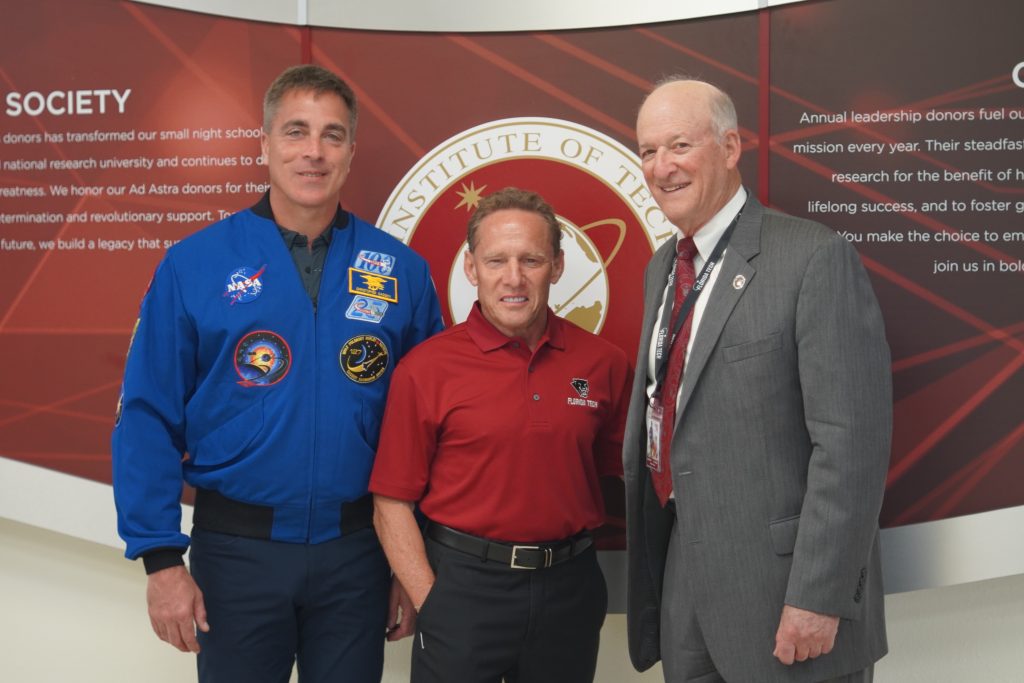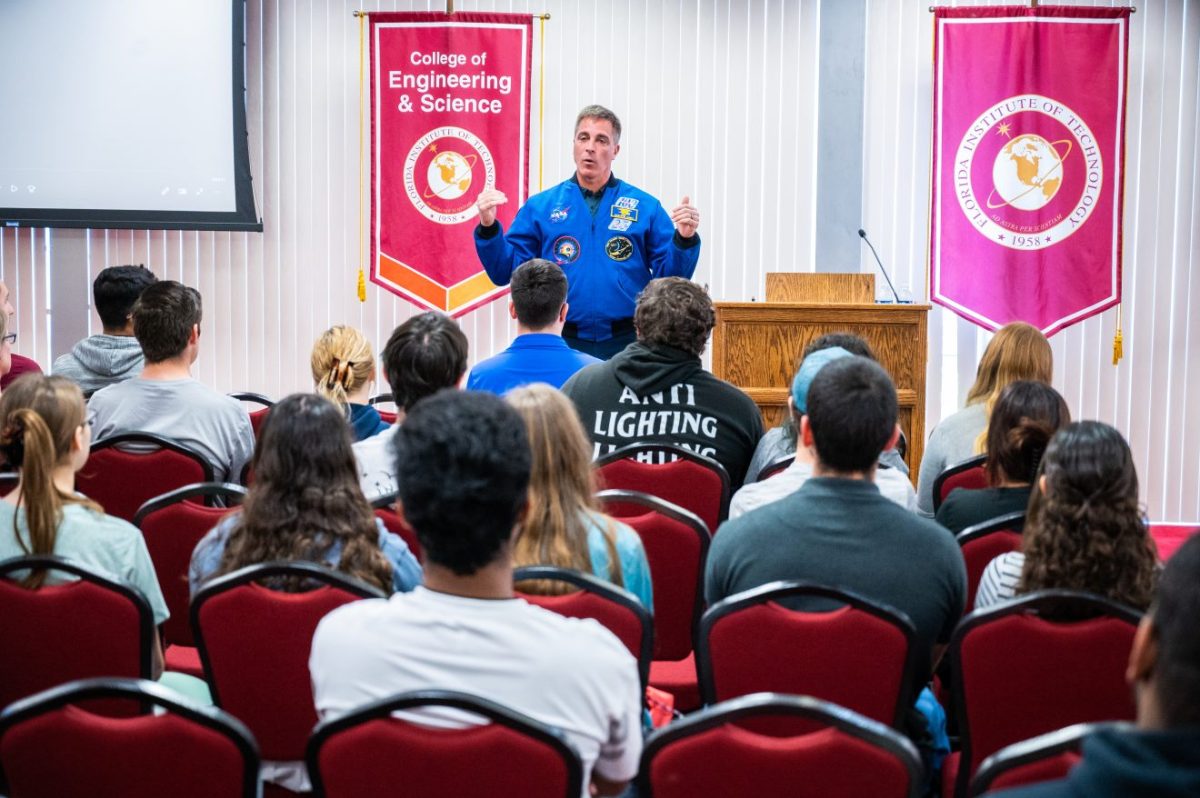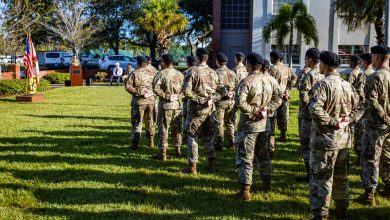Astronaut Chris Cassidy Visits Florida Tech, Speaks to Students
Veteran of Three Shuttle Flights Also a Navy SEAL
By the time Chris Cassidy found himself in a window seat on space shuttle Endeavor as it soared into the inky depths above Kennedy Space Center, he had already lived a life worthy of a Hollywood movie.
Naval Academy graduate. Master’s degree in ocean engineering from MIT. Navy SEAL for 11 years, starting with a deployment to Afghanistan two weeks after the 9/11 attacks. Recipient of two Bronze Stars. Finisher in the Ironman World Championship triathlon (that’s where you swim 2.4 miles, bicycle 112 miles, and conclude with a 26.2-mile run).
All of that behind him in the early 2000s, Cassidy found himself anxiously awaiting a phone call. He was home from his second six-month deployment to Afghanistan. The phone rang.
“Hey Chris, this is Kent Rominger,” said NASA’s chief astronaut at the time. “Would you like to come to work for us at the Johnson Space Center and fly in space?”
Chris Cassidy, already a Navy captain, had a new title: astronaut.
“This was in 2004, and I remained in Houston for the next 17, almost 18 years,” Cassidy told students and faculty during a special appearance on campus Feb. 27. He added, “And a couple space flights.”
Three space flights to be exact for a combined 378 days in space, including nearly 55 hours of spacewalk time.
Cassidy’s illustrious career was fueled by what his friend Jim Shafer said could – should – be within all of us: passion and heart. Shafer, a successful neurologist in Vero Beach and Einstein Bros. Bagels franchisee who owns the location in the Denius Student Center food court, made Cassidy’s visit possible. In introducing the astronaut, Shafer offered some advice to students.

“Be passionate about everything you do. I mean, that’s really the heart of it,” Shafer told the crowd. “And the other thing is heart. You’ve got to be all in, all the time. So if you are both of those things, you’re going to accomplish a lot of great things. Chris has done it.”
In his remarks, Cassidy explained how he ended up at the Naval Academy, some of his experiences becoming a Navy SEAL and what it was like on his first shuttle mission, 2009’s STS-127 on Endeavor.
On the notoriously difficult BUD/S training, which includes a grueling stretch of physical conditioning known as Hell Week, Cassidy talked about one of the key messages learned: you can’t do it all by yourself.
“You don’t get through Hell Week by yourself, and just like life or school or exam week, you get through it together with the people that you care for and your classmates and your teammates and your family, people that you love. That’s how you get through life.”
A few highlights of his shuttle experience:
On arriving at the pad the night of the launch:
“So the bus turns the corner and starts going up to the ramp that delivers you to the launchpad, and the shuttle is illuminated by this gigantic lighting system, and it’s like this beacon of light on top of this hill. You’ve been to the launchpad many times. Normally, it’s forklifts and hard hat, and trucks beep, beep beep backing up, and noise and craziness. This day there’s nothing. The only vehicle going to the pad is the bus you’re in, everything else is going away.
I remember getting out and just looking up, and you see steam coming off, and ice on the structure, and the metal I-beams. You can almost hear them moaning because this energy that’s trapped up in this fully fueled rocket, and you just kind of realize, ‘Holy moly, we’re getting in that thing.’”
On lifting off and blasting into space:
“I thought right at that moment, maybe just like you, that it would be this incredible push in my back as the rocket leapt off the pad, but it wasn’t. It was almost like a gentle push. (At lift off) it didn’t feel like a whole lot of acceleration. At 10 seconds, 20 seconds, 30 seconds, 40 seconds, you’re really feeling the full force of that acceleration, which is three-and-a-half times the force of gravity directed at your chest and you’re just riding the thing like crazy.
The (shuttle ride) was super bumpy, like a heavy dump truck on a bumpy dirt road, for the first two minutes, and then the solids (rocket boosters) fell away, and it became really silky smooth, almost like you couldn’t even perceive motion for the last 6 ½ minutes. The total flight is 8 ½-minutes long. The engines cut off and you’re in zero gravity.”

On first seeing Earth from space:
“I get the camera (to document the orange liquid fuel tank’s return toward Earth) and I’m taking the picture, picture, picture, picture, picture, picture, and I’m just like looking through this giant straw, basically a telephoto lens, at an orange blob. I have this mapping thing that I’m supposed to do, and then halfway through it says to change the camera lens. So I take the camera down, go to change the camera lens, and at that moment, instead of looking through the straw, now I’m looking out the window and what do I see? I see Earth for the first time. It was unbelievable, and I look at my watch and we’re like 35 minutes into the mission. Where were we 35 minutes ago? In Cocoa Beach, zero knots, zero altitude. And now I’m looking over Spain in 35 minutes.
And if you’ve ever taken an international flight, it’s way longer than 35 minutes to get to Spain, and so I realized, “Wow. We are going so fast, and there’s the Earth zipping by,” and you just see this blue and green and brown, and I saw the Straits of Gibraltar, and white clouds, and it was just unbelievable.”
On the impact of seeing Earth:
“The whole experience made me much more Earth aware, much more Earth conscious, realizing that the spaceship we’re in is a mechanical thing that’s keeping everybody alive, but Earth is not so much different. It’s a thing that’s keeping all 8 billion people alive as we all zip around through the galaxy, through the universe, and it just made me really appreciate what Earth does for all of us. And you see this little bitty skinny thing that’s the atmosphere, which is like the skin of the ship, and I think the world would be better off if everybody had five minutes to look out the window.”
On reentry on a Soyuz capsule:
“I had a window right by my head. You can look out, and as soon as you start to get in touch with the plasma the thermal environment starts to change, the hue goes from a normal color to a little bit more red, a little bit more red, and then this fiery pink, and then the whole capsule becomes this pink color inside, and you have to really not think about that nine inches from your melon is 2,000-degree plasma on the other side of that window. So you kind of look a little bit and you go, ‘I don’t want to look anymore.’”





